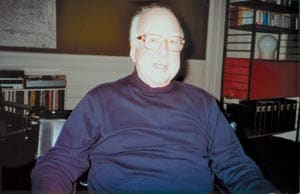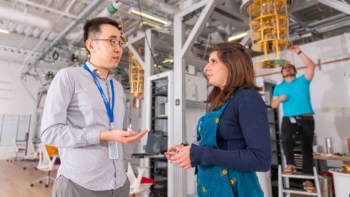This month 40 years ago Peter Higgs wrote two papers that might explain the origins of mass. However, as Peter Rodgers discovers, he is reluctant to take too much of the credit.
Symmetry is a powerful concept in physics, but sometimes you can have too much of it. If the Standard Model of particle physics were perfectly symmetric, none of the particles in the model would have any mass. Looked at another way, the fact that most fundamental particles have non-zero masses breaks some of the symmetry in the model. Something must therefore be generating the masses of the particles and breaking the symmetry of the model. That something – which has yet to be detected in an experiment – is called the Higgs field.
Named after Peter Higgs of Edinburgh University, the Higgs field pervades the entire universe. And just as all the particles in the Standard Model – the quarks and leptons that make up matter, and the vector bosons that carry forces – are associated with fields, there is a particle called the Higgs boson associated with the Higgs field. Detecting the Higgs boson would represent an enormous breakthrough in particle physics.
However, Higgs himself seems embarrassed by the fame that his eponymous boson has brought. In conversation he talks about “the so-called Higgs field” and the “so-called Higgs model”, and is keen to give credit to a host of other physicists whose work has lead to our current understanding of the generation of mass within the Standard Model.
What is the Higgs?
In 1993 the UK’s science minister at the time, William Waldegrave, asked physicists to explain in simple terms – and on one side of A4 – what the Higgs boson is, and why they wanted to find it. With a bottle of vintage Champagne on offer for the best explanation, physicists rose to the challenge with analogies that ranged from cocktail parties to space having a “grain” like a piece of wood, albeit in an abstract space rather than real space (Physics World September 1993 pp26-28). In the latter example, particles that travel with the grain have no mass, like the photon, while those that travel against the grain have large masses, like the W and Z bosons.
The direction of the grain in the Higgs field is determined by a process called spontaneous symmetry breaking. In the early universe, the Higgs field looked the same in all directions, but this symmetry was spontaneously broken shortly after the Big Bang, in much the same way the perfect symmetry of a pencil standing on its tip is spontaneously broken when the pencil falls over and defines a direction in space.
For Higgs, the story of the particle that bears his name started in 1961, shortly after he got a lectureship at Edinburgh. He had switched to particle theory after receiving a PhD from King’s College London for a thesis on the vibration spectra of molecules. He then spent six years moving back and forth between Edinburgh, University College London and Abdus Salam’s group at Imperial College before landing the permanent position.
“When I moved back to Edinburgh in October 1960 I was not sure where I was going next,” he recalls. That all changed the following year when he read a paper by Yoichiro Nambu that based a theory of elementary particles on an analogy with the BCS theory of superconductivity. “This is where the idea of a spontaneously broken symmetry being the way in which the mass of particles could be generated first arose,” says Higgs. “Although my name gets thrown around in this context, it was Nambu who showed how fermion masses would be generated in a way that was analogous to the formation of the energy gap in a superconductor.”
There was, however, a problem with the Nambu approach. Although the spontaneous breaking of symmetry generated particles with mass, Jeffrey Goldstone, Salam and Steven Weinberg had shown that it also generated a particle known as a Goldstone boson that had no mass. This was bad news because no such particle was known to exist.
Once more help arrived from the condensed-matter community when, in 1963, Phil Anderson pointed out that the equivalent of a Goldstone boson in a superconductor could become massive due to its electromagnetic interactions. But did Anderson’s argument apply in the relativistic case? No, said a paper by Walter Gilbert in an issue of Physical Review Letters that arrived in Edinburgh the middle of July. Yes, said Higgs, after thinking about it over the weekend.
A tale of three papers
Higgs had found a loophole in the proof of Goldstone and co-workers and wrote a short paper called “Broken symmetries, massless particles and gauge fields” that was received by the editors of Physics Letters at CERN on 27 July. Higgs was able to show that the introduction of a subtle form of symmetry known as gauge invariance invalidated some of the assumptions made by Goldstone, Salam and Weinberg in their proof. The paper that explained this contained only 79 lines of text and just five equations (Physics Letters 12 132).
Higgs quickly started on a follow-up paper. “The first paper merely says that there is no obstacle to this sort of theory,” he says. “The obvious thing to do was to try it out on the simplest gauge theory of all, electrodynamics – to break its symmetry to see what really happens.” Higgs found that he had a theory in which there was one massive spin-one particle – the sort of particle that can carry a force – and one left-over massive particle that did not have any spin. A new type of particle, a primitive version of the Higgs boson, had made its debut – in theory at least.
This second, equally short, paper was also sent to Physics Letters. However, it was rejected because – as Higgs later heard through a third party – the editors felt that “it was of no obvious relevance to physics”. Higgs decided to write an extra paragraph on possible applications to the strong interaction. “This was not particularly realistic,” he recalls, “but it showed that you could break flavour symmetries in this way and generate massive vector mesons. This paragraph is perhaps why I get credited with the so-called Higgs boson.”
Higgs’ revised version arrived at Physical Review Letters on 31 August, the same day that it published a paper in which Fran&ccdeil;ois Englert and Robert Brout of the Free University of Brussels used Feynman diagrams to reach essentially the same conclusions.
After the matter
So what happened after 1964? “There is a sort of mythology that grows up about what happened, which is different from what really did happen,” says Higgs. “None of us – not me, or Brout and Englert – tried the right application. We were fixated by the strong interaction.” The right application turned out to the unification of the electromagnetic and weak interactions into a single electroweak force – a feat that earned Salam, Weinberg and Sheldon Glashow the Nobel prize in 1979.
But if Higgs sometimes feels he missed out on the electroweak theory because he was concentrating on the strong force, he is equally aware that he might have missed out on the Higgs boson itself if Phil Anderson had written more about elementary particles in his 1963 paper. “Anderson should have done basically the two things that I did,” says Higgs. “He should have shown the flaw in the Goldstone theorem, and he should have produced a simple relativistic model to show it happened. However, whenever I give a lecture on the so-called Higgs mechanism I start off with Anderson, who really got it right, but nobody understood him.”
So how does he feel about his name being attached to the biggest prize in particle physics? “Most of what has been attached to my name should not have been,” he replies, “but probably the Higgs boson is correctly attached because I was probably the person who drew attention to it most in my papers. However, as far as the mechanism of generating vector boson masses is concerned, I usually write down a whole string of names, starting with Anderson and including Englert and Brout, Gerald Guralnik, Dick Hagen and Tom Kibble, and also Gerard ‘t Hooft.”
Higgs remained active in particle theory into the 1970s, but says he “got rather left behind” when Martinus Veltman and ‘t Hooft made the next big breakthrough in the field by showing that renormalization could be used to remove the infinities in the electroweak theory – a feat for which they shared the 1999 Nobel prize. Eventually Higgs decided that he was “getting on a bit for a theorist” and decided to concentrate on teaching and “one or two minor things” involving other types of symmetry in quantum mechanics.
Higgs hit the headlines in September 2002 when an article headlined “Clash of the atom-smashing academics” appeared in the Scotsman newspaper. The story concerned remarks that Higgs made about Stephen Hawking to a journalist over dinner. Higgs was reported to have said, among other things, that Hawking’s celebrity status has given him undeserved instant credibility, and that communication between Hawking and theorists in other fields was difficult. The story, which was picked up by other newspapers, also reported how Hawking had won a bet that the Higgs boson would not be found at the Large Electron Positron collider at CERN.
Higgs quickly wrote to Hawking explaining the context in which he made the remarks and Hawking wrote back saying that he was not offended – but adding that he still thought that experimentalists would not find the Higgs boson.
However, Higgs remains “pretty confident” that the boson will be found. “What else can be keeping the agreement between the Standard Model and the data just as good as it is?” he asks. “If there is not a Higgs boson, the theory does not make sense at all.”




